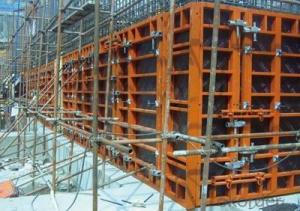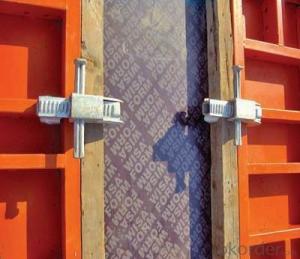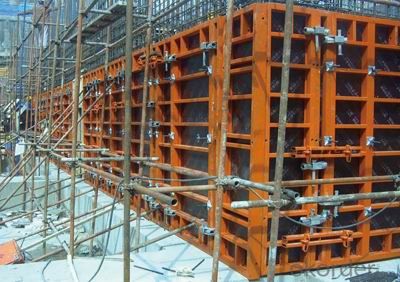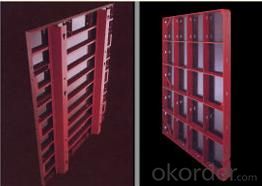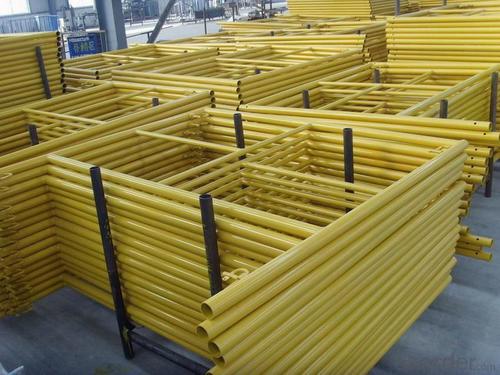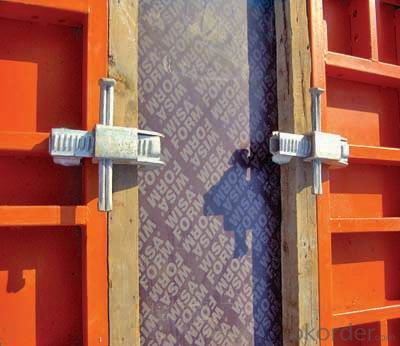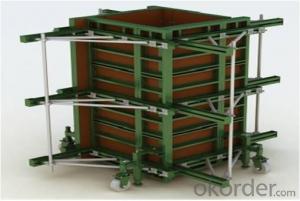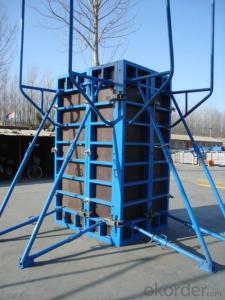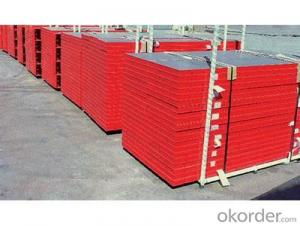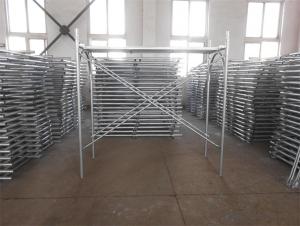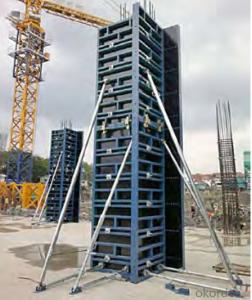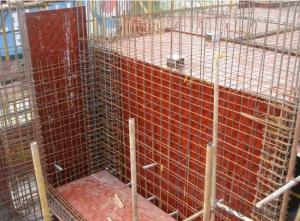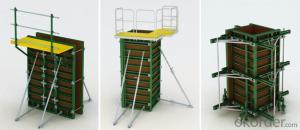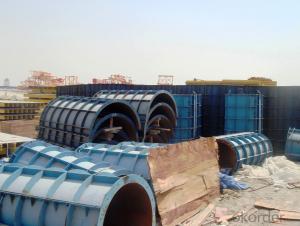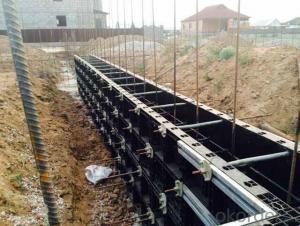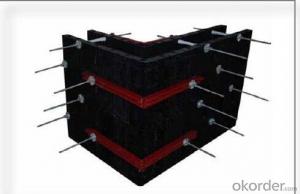Steel Frame Formwork with High Quality and Strong Strength
- Loading Port:
- Shanghai
- Payment Terms:
- TT OR LC
- Min Order Qty:
- 1 m²
- Supply Capability:
- 100000000 m²/month
OKorder Service Pledge
OKorder Financial Service
You Might Also Like
1. Structure of Steel Frame Formwork GK120
There is a prizing part designed in the corner, which can help to position and remove formwork easily.
The plywood is screwed on from the back when connecting frame and plywood, so the surface of the finished concrete is perfect.
The formwork series are a complete system with a full set of accessories, and can be set up flexibly according to project demand.
2. Main Features of Steel Frame Formwork GK120
High strength
High standardized system
Convenient for construction
Easy to control the quality
Easy, rapid and economical.
3. Steel Frame Formwork GK120 Images
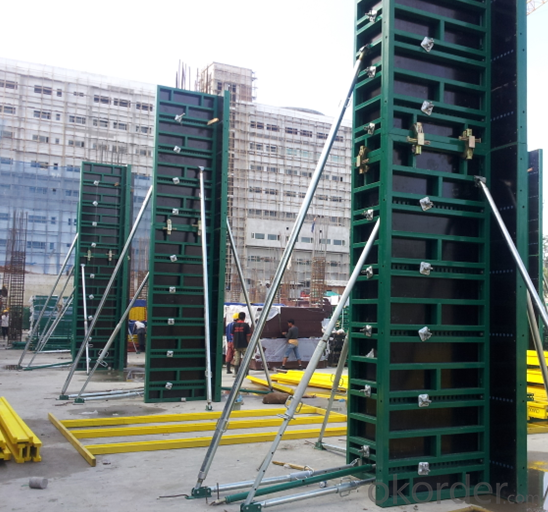
4. Steel Frame Formwork GK120 Specification
-The steel frame formwork is plywood covered with hollow steel. The plywood is 18 mm thick.
-The frame is highly strengthened, and the wall formwork can bear lateral pressure 60 KN/m2 while the column formwork can bear 80 KN/m2.
-As a standardized system, it is flexible to assemble , wood batten can be filled to satisfy the need f of non-standard size.
-The adjustable steel clamp is convenient to use, and can hold tightly.
-There is a prizing part designed in the corner, which can help to position and remove formwork easily.
-The plywood is screwed on from the back when connecting frame and plywood, so the surface of the finished concrete is perfect.
-The formwork series are a complete system with a full set of accessories, and can be set up flexibly according to project demand.
5. FAQ of Steel Frame Formwork GK120
1) What can we do for you?
.We can ensure the quality of the vinyl banner and avoid extra expenses for customers.
.We can provide you the professional design team.
.We can provide fashionable and newest styles for you.
.We can design the artwork for you.
2) What promises can be done by us?
. If interested in Steel Frame Formwork GK120, please feel free to write us for any QUOTE.
. Please DO check goods when courier knocks your door and contact us asap if any issue.
3) What about of our after-sale service?
. Response will be carried out in 24hours after receiving any complain or request.
. Steel Frame Formwork GK120 cost can be refund after order is confirmed.
4) What about the package and shipping time?
.Packing: As Customer's Requirements
.Shipping: We have various shipping ways for our customers, such as express which including TNT, DHL, FEDEX, UPS, EMS, etc. ; by air/ sea, and we are VIP of these express.
.Shipping time:
Normally small orders, it just 10-15 business days to arrive your hand; When comes to the customs declaration, it may need 7 days.
- Q: What are the different types of concrete surface finishes achievable with steel frame formwork?
- Steel frame formwork allows for the attainment of various concrete surface finishes. These include: 1. Smooth Finish: The most commonly achieved finish with steel frame formwork. It yields a smooth and uniform surface suitable for most applications. It is attained by ensuring proper alignment of the formwork and correct pouring and vibration of the concrete. 2. Exposed Aggregate Finish: This finish involves the use of specialized formwork with inserts or panels featuring a textured surface. When concrete is poured into the formwork, the textured surface creates a pattern or design on the final concrete surface. This finish is often used for decorative purposes, such as sidewalks, driveways, and outdoor patios. 3. Stamped Finish: A stamped finish is attained by employing steel frame formwork with imprinted patterns or designs on its surface. Once the concrete is poured and cured, the formwork is removed, leaving behind a concrete surface with the desired pattern. This finish is commonly used for decorative flooring or walls. 4. Polished Finish: A polished finish is achieved using steel frame formwork with a smooth and flat surface. After pouring and curing the concrete, special tools and techniques are used to polish it, resulting in a glossy and reflective surface. This finish is often employed in upscale applications like commercial buildings, showrooms, or museums. 5. Textured Finish: This finish is accomplished by utilizing steel frame formwork with a textured surface, such as a pattern or design. Once the concrete is poured and cured, the formwork is taken off, revealing a concrete surface with the desired texture. This finish is frequently used in areas requiring a non-slip or non-skid surface, such as parking garages or industrial floors. To summarize, steel frame formwork offers a wide range of possibilities for achieving diverse concrete surface finishes. Whether you seek a smooth and even surface, an exposed aggregate finish, a stamped design, a polished appearance, or a textured surface, steel frame formwork can help you attain the desired outcome.
- Q: What are the different types of finishes that can be achieved using steel frame formwork?
- Construction projects can achieve different types of finishes by utilizing steel frame formwork. 1. Smooth Finish: By using steel formwork panels, a flat and even surface can be created, resulting in a smooth finish once the concrete is poured and set. 2. Textured Finish: Textured finishes can also be achieved by employing pre-designed steel formwork panels that have patterns or textures imprinted on them. When the concrete is poured into these panels, it replicates the texture, resulting in a textured finish. 3. Exposed Aggregate Finish: To achieve an exposed aggregate finish, rough or textured formwork panels are utilized. After pouring the concrete into these panels, the top layer is removed to expose the aggregate underneath, creating a visually appealing and textured finish. 4. Stamped Finish: Specially designed formwork panels with patterns or designs imprinted on them can be employed to create stamped finishes. When the concrete is poured into these panels, the patterns are transferred onto the surface of the concrete, creating a stamped finish. 5. Architectural Finish: Steel frame formwork allows for various architectural finishes, such as ribbed, fluted, or curved surfaces. The flexibility of steel formwork enables the creation of unique and intricate architectural designs and finishes. In conclusion, steel frame formwork offers a wide range of finishes that can enhance the overall look of construction projects. These finishes include smooth, textured, exposed aggregate, stamped, and architectural finishes, each providing aesthetic appeal.
- Q: Can steel frame formwork be used for both single-storey and multi-storey structures?
- Yes, steel frame formwork can be used for both single-storey and multi-storey structures. Steel frame formwork is a versatile and durable system that can be easily adjusted to accommodate different heights and configurations. It provides excellent strength and stability, making it suitable for high-rise buildings and structures with multiple floors. Additionally, steel frame formwork allows for efficient and rapid construction, reducing project timelines and costs. Therefore, it is commonly used in both single-storey and multi-storey construction projects.
- Q: Can steel frame formwork be used for both single-storey and multi-storey construction?
- Steel frame formwork is an adaptable and long-lasting system that can be utilized for both single-storey and multi-storey construction purposes. It is easy to assemble and dismantle, making it suitable for a wide range of construction projects. Regardless of whether it is a single-storey or multi-storey structure, steel frame formwork can offer the necessary support and stability during the concrete pouring and curing process. The steel frames can be adjusted and modified to accommodate varying floor heights and layouts, providing flexibility in construction design. Moreover, steel frame formwork has a high load-bearing capacity, ensuring the structural integrity of both single-storey and multi-storey buildings.
- Q: What are the different types of supports and props used with steel frame formwork?
- Steel frame formwork systems commonly utilize various types of supports and props to ensure stability and support. These components are crucial for proper formation and maintenance of the concrete structure throughout the construction process. Some examples of supports and props used in conjunction with steel frame formwork are as follows: 1. Adjustable Steel Props: Telescopic steel tubes that can be adjusted to different lengths are frequently employed to support horizontal formwork elements like beams and slabs. Their adjustable feature enables easy height adjustment and guarantees stability during concrete pouring. 2. Tripod Supports: These supports consist of three legs with adjustable heights and are used to support vertical formwork elements, such as columns and walls. Tripod supports offer stability and can be easily adjusted to accommodate various formwork heights. 3. Soldier Props: Vertical supports made of steel, soldier props are commonly used to support vertical formwork elements like walls. They are adjustable in height and provide stability. Soldier props are often used in conjunction with other supports to enhance reinforcement. 4. Scaffolding: Scaffolding is a temporary structure used to support workers and materials during construction. It is frequently employed alongside steel frame formwork systems to provide additional support and access to different areas of the structure. Scaffolding is usually constructed of steel or aluminum and can be easily assembled and disassembled. 5. Formwork Brackets: These brackets are used to support horizontal formwork elements, such as beams and slabs. They are typically attached to the structure using bolts or clamps and provide extra support and stability during concrete pouring. Formwork brackets are often adjustable to accommodate different formwork heights and configurations. 6. Wall Ties: Wall ties are used to hold formwork panels together and provide stability to vertical formwork elements like walls. Typically made of steel, they are secured to the formwork panels using nuts and bolts. Wall ties ensure the formwork panels remain in place during concrete pouring and curing. In summary, the diverse range of supports and props used with steel frame formwork systems are meticulously designed to offer stability, support, and flexibility during the construction process. These components are essential in maintaining the formwork in place, enabling the proper formation of concrete structures.
- Q: What are the different components of steel frame formwork?
- The different components of steel frame formwork include steel panels, horizontal beams, vertical props, diagonal braces, connectors, and adjustable clamps.
- Q: Can steel frame formwork be used for curved structures?
- Indeed, curved structures can be constructed using steel frame formwork. The versatility of steel frame formwork allows for effortless adjustments or modifications to form curved or intricate shapes. This is accomplished by implementing flexible plywood or metal sheets that can be flexed or contoured to conform to the desired curve. Moreover, steel frame formwork offers exceptional durability and steadfastness, rendering it suitable for erecting both linear and curved structures.
- Q: How does steel frame formwork handle vertical and horizontal loads?
- Steel frame formwork is specifically designed to handle both vertical and horizontal loads. When it comes to vertical loads, such as the weight of the concrete being poured, the steel frame formwork provides excellent support and stability. The robust steel frame structure ensures that the formwork can withstand the pressure and weight of the concrete, preventing any deformations or failures. Additionally, the formwork is usually reinforced with strong steel bars or mesh to further enhance its load-bearing capacity. In terms of horizontal loads, steel frame formwork is designed to resist lateral forces, such as wind or seismic loads, effectively. The steel frame structure provides the necessary rigidity and strength to counteract these forces and prevent any significant movements or displacements. Moreover, the joints and connections between the steel members are carefully designed and constructed to ensure proper load transfer and distribution, minimizing the risk of failure under horizontal loads. Overall, steel frame formwork is engineered to handle vertical and horizontal loads with great efficiency and reliability. Its robust structure, reinforced elements, and well-designed connections contribute to its ability to support the weight of the concrete and resist lateral forces, resulting in a safe and durable formwork system.
- Q: What are the key considerations for selecting the appropriate steel frame formwork manufacturer?
- When choosing the right steel frame formwork manufacturer, there are several important factors to take into account. These factors include the manufacturer's experience and expertise, the quality and durability of their products, their ability to meet project requirements and deadlines, their customer service and support, and the cost-effectiveness of their solutions. First and foremost, it is crucial to consider the manufacturer's industry experience and expertise. A manufacturer with a long-standing reputation and extensive knowledge is more likely to produce top-notch steel frame formwork. It is essential to select a manufacturer that has a proven track record of successful projects and can provide references from satisfied customers. Next, thoroughly evaluate the quality and durability of the manufacturer's products. Steel frame formwork plays a critical role in construction projects, so it must be reliable and robust. It is important to choose a manufacturer that uses high-quality materials and employs advanced manufacturing techniques to ensure the longevity and strength of their products. In addition, the manufacturer's ability to meet project requirements and deadlines should be a key consideration. They should have the capacity to produce and deliver the required quantity of steel frame formwork within the specified timeframe. This includes assessing their production capabilities, inventory management, and logistics capabilities to ensure a smooth and punctual supply of the necessary products. Furthermore, it is vital to assess the manufacturer's customer service and support. A dependable manufacturer should be responsive to inquiries, offer technical assistance, and provide after-sales support. They should have a dedicated customer service team that can address any concerns or issues that may arise during the project. Lastly, consider the cost-effectiveness of the manufacturer's solutions. While prioritizing quality and reliability, it is also important to ensure that the chosen manufacturer offers competitive pricing. It is advisable to obtain quotes from multiple manufacturers and compare them based on product quality and level of service provided. In conclusion, the selection of an appropriate steel frame formwork manufacturer requires careful consideration of their experience, product quality, ability to meet project requirements, customer service, and cost-effectiveness. By thoroughly evaluating these key factors, one can choose a reliable and trustworthy manufacturer that will meet the specific needs of their construction project.
- Q: How does steel frame formwork affect the overall sound insulation of a concrete structure?
- The overall sound insulation of a concrete structure can be significantly improved by incorporating steel frame formwork. Compared to traditional wooden formwork, the use of steel frames creates a more stable and rigid structure. This increased rigidity effectively reduces vibrations and minimizes sound transmission throughout the structure. One of the key factors that affect sound insulation in concrete structures is the transmission of airborne sound waves. The solid barrier provided by the steel frame formwork effectively blocks these sound waves, limiting their ability to pass through the structure. This greatly enhances the sound insulation performance of the concrete structure. Additionally, steel frame formwork also contributes to the reduction of impact noise. Impact noise is typically caused by vibrations transmitted through the structure from activities like footfall, movement of objects, or machinery. By minimizing vibrations, the use of steel frames reduces the transmission of impact noise. It is important to note that while steel frame formwork can improve sound insulation, other factors such as the thickness and density of the concrete, the presence of additional insulation materials, and the overall design and construction of the structure also play a significant role. Thus, it is crucial to adopt a comprehensive approach to sound insulation in concrete structures, considering all relevant factors.
Send your message to us
Steel Frame Formwork with High Quality and Strong Strength
- Loading Port:
- Shanghai
- Payment Terms:
- TT OR LC
- Min Order Qty:
- 1 m²
- Supply Capability:
- 100000000 m²/month
OKorder Service Pledge
OKorder Financial Service
Similar products
Hot products
Hot Searches
